By Frank Iannamico and Chris Cox
General Motor’s Hydra-Matic Division
The United States’ direct military involvement in Vietnam ended in 1973. During most of the war, the standard “A” infantry weapon of U.S. troops was the 5.56mm M16 rifle.
Colt’s Patent Fire Arms Company was the manufacturer of the M16 and held the exclusive rights to the design. As the Vietnam War was escalating, more rifles were needed and the U.S. government wanted to establish a second source for the weapons. However, Colt resisted the idea of relinquishing the manufacturing rights and the M16 Technical Data Package to the government—despite paying Armalite only $325,000 for the right to manufacture and market the AR-15. Colt’s position was that they took a chance on the AR-15. At the time they bought the rights to the weapon in 1959, it had already been rejected by the Army.

Finally, on June 30, 1967, a contract was signed for the manufacturing rights and the Technical Data Package for the M16, M16A1 and XM-177 rifles, thus allowing the U.S. government to start the bidding for a second source to produce the weapons. Colt received a payment of $4,500,000 and a 5.5% royalty on all future weapons and parts procured by the government. During November of 1969, the XM-177 rifles were deleted from the contract agreement.
Initially there were 26 firms interested in a government contract to produce M16A1 rifles, but only 12 firms made bid deposits. After obtaining the Technical Data Package for review, only 8 remained interested in bidding. After intensive negotiations with the interested parties, GM’s Hydra-Matic Division and Harrington & Richardson (H&R) were awarded contracts. The decision immediately came under fire from members of Congress. The decision to use H&R was in question because of their marginal performance during their M14 rifle contracts. Hydra-Matic had manufactured the M39 20mm cannons, but had no experience with small arms. Bidders with successful small arms manufacturing experience like Saco-Lowell (who produced the M60 machine gun) and Cadillac Gage (who manufactured the Stoner weapon systems) were not chosen. The 65-member Source Selection Board making the decision felt that GM and H&R were positioned to get the urgently needed rifles in production the fastest.
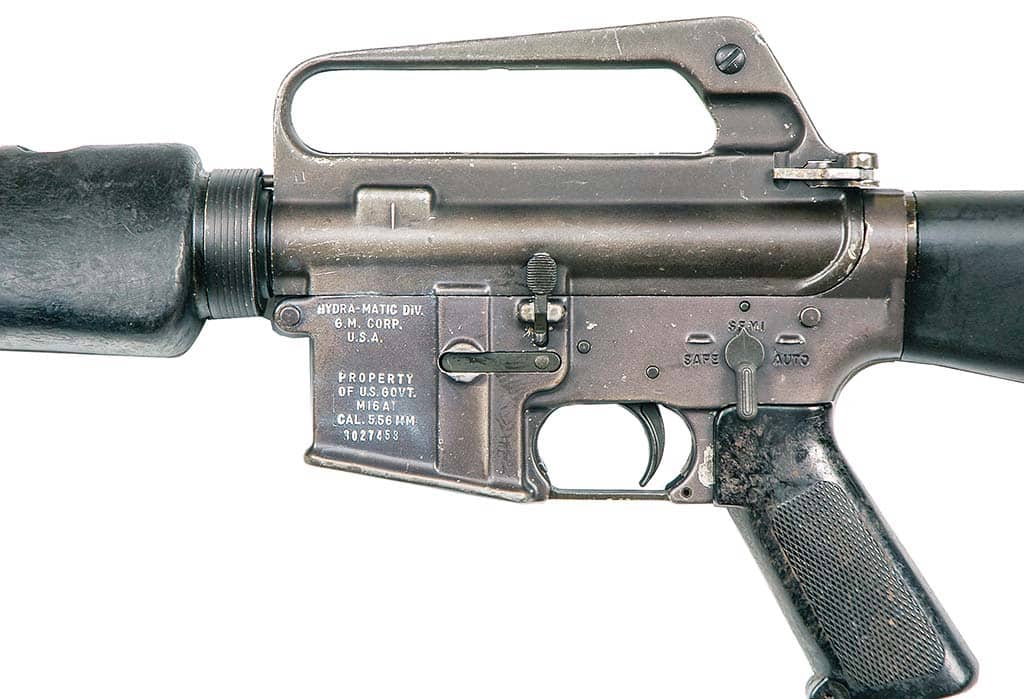
a GM/Hydra-Matic receiver. All Hydra-Matic serial num-bers were in the 3-million range. ATF FIREARMS TECHNICAL DIVISION
General Motors
During World War II, General Motors, better known as GM, had a long history of manufacturing military hardware by its many divisions. The hardware included, but was not limited to, ordnance, tanks, vehicles, machine guns, carbines and submachine guns.
The Hydra-Matic Division
General Motors’ Hydra-Matic Division was founded in May 1939 as the Detroit Transmission Division. It was created to continue the developmental work begun by Cadillac engineering and to manufacture the newly developed Hydra-Matic automatic automobile transmission. In 1962, the Division officially changed its name to the Hydra-Matic Division.
After the government procured the manufacturing rights for the M16A1 rifle, then Secretary of Defense, Robert McNamara, approved the Department of Defense’s plan to expand M16 production in March of 1968. Estimated ceiling prices with non-reoccurring startup costs were: first year production of 60,000 rifles at a cost of $316 each, second-year production 180,000 rifles at $105 each. The learning curve in the small arms industry was estimated to be 98%. The establishment of multiple sources for M16 production was not considered to be economically justified unless GM was at least 60% below the established ceiling price. Colt was producing M16A1 rifles at a cost of approximately $104 each.
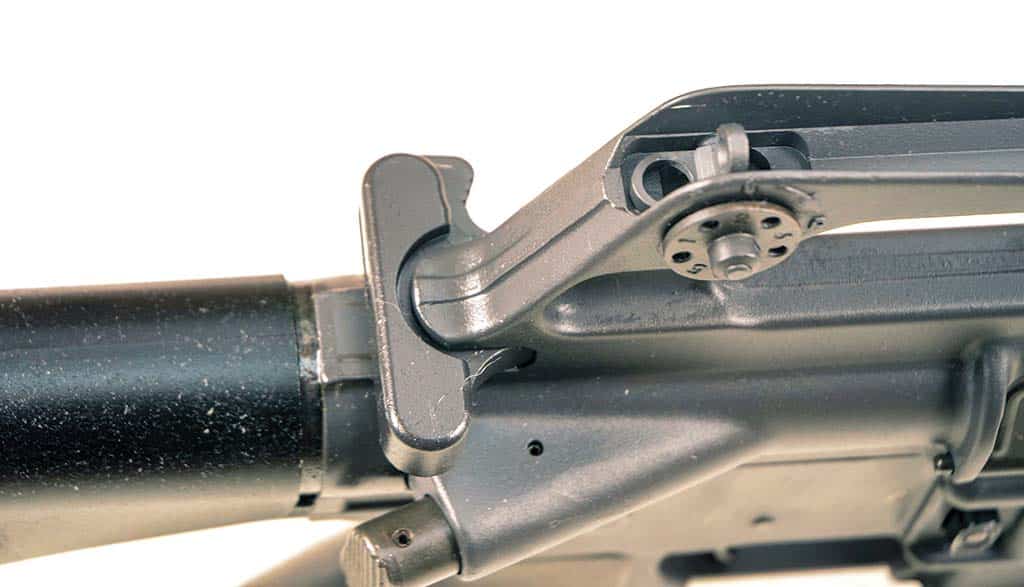
Hydra-Matic received a sole source, one-year contract, number DAAF03-68-C-0048, dated April 19, 1968, for 240,000 M16A1 rifles. Cost per rifle for the first contract was established at $151.54, well below the estimated ceiling price. The contract prices did not include the reoccurring cost of $8.68 for seven magazines or the $4,500,000 and 5.5% royalty paid to Colt for the rights to establish a second source production.
A GM plant in Ypsilanti, Michigan was chosen as the location for the manufacture of the M16A1 with the first deliveries to be during January of 1969. Production was to level off at 25,000 rifles per month. GM shipped the 100,000th M16A1 rifle to the Army two months ahead of the required schedule. It became apparent that GM/Hydra-Matic was proving capable of quality production ahead of schedule, while H&R was struggling with production and quality issues.
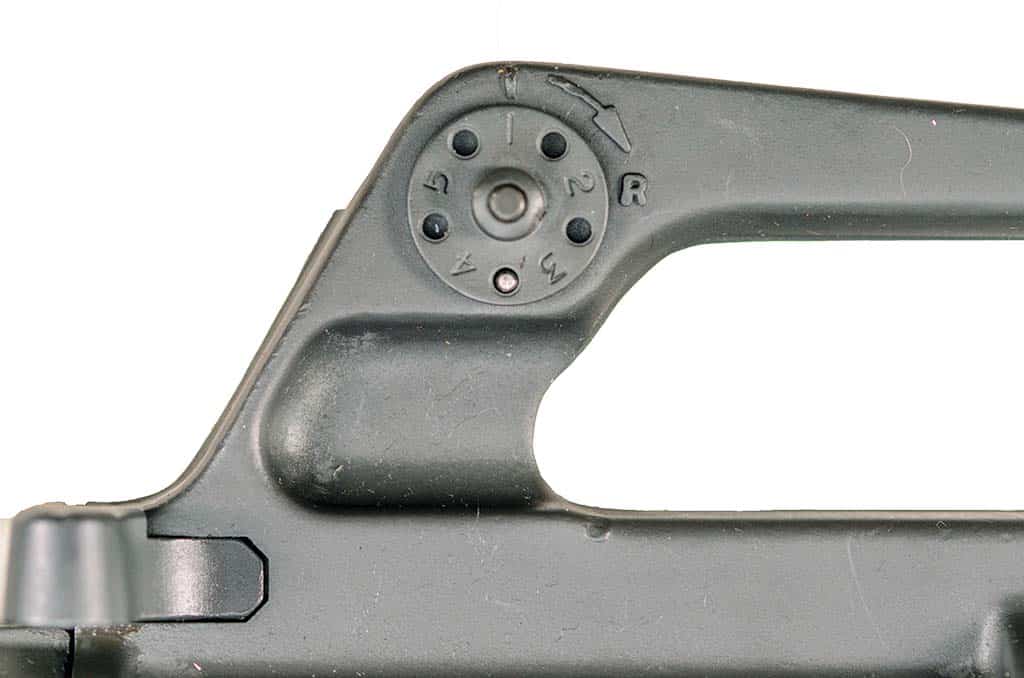
A year later, the company had delivered another 140,000 rifles. On July 18, 1969, Hydra-Matic was awarded a second contract, DAAF03-70-C-002, for an additional 229,217 M16A1 rifles at a cost of $99.74 each. All the GM-produced M16A1 rifles were serial numbered in the 3,000,000 range.
Original GM/Hydra-Matic M16A1 rifles, manufactured over 50 years ago, are quite rare. There are not many original transferable U.S. Property marked Colt, GM or H&R M16 rifles in the NFA registry. Occasionally when they are offered for sale, the asking price is in the mid to high five-figure range. Buyer Beware: There are some M16 rifles in the NFA registry that were destroyed by the government and welded back together and registered prior to the cut-off date of May 19, 1986. An M16 with a receiver that was cut and welded back together would be priced considerably less than an original uncut one. An article describing the receiver welding process appeared in an old FIREPOWER magazine dated July of 1986, ironically published two months after the ban of the new registration of transferable machine guns.
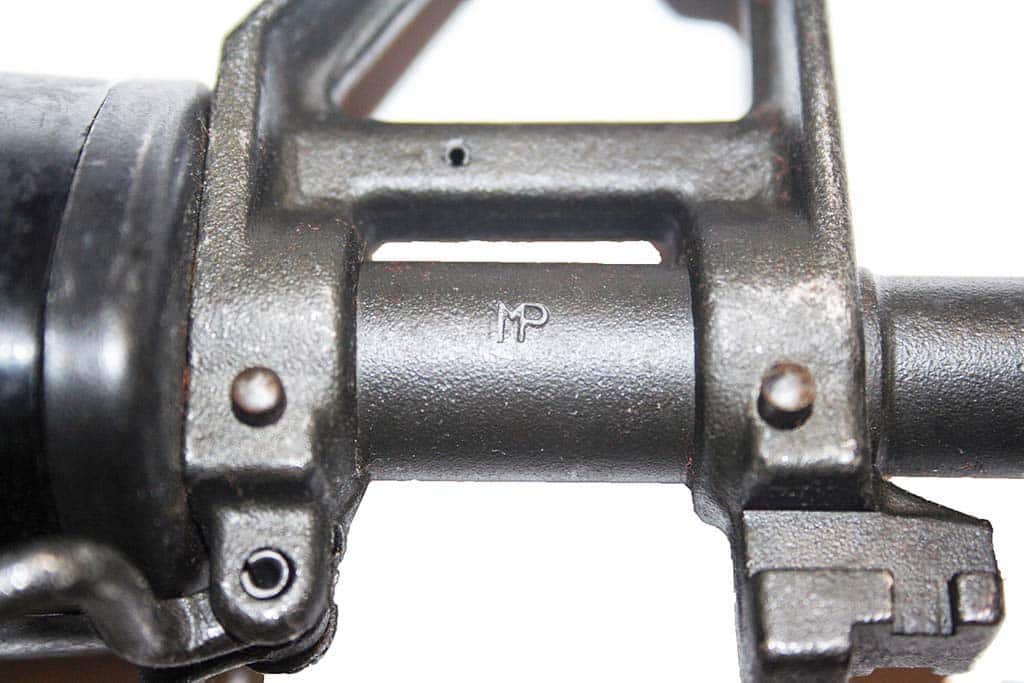
The AR-15/M16 rifle has come a long way since it first appeared in the jungles of Vietnam. After a controversial and troublesome start, the rifle is now one of the most popular civilian semiautomatic firearms in the U.S. Currently, there are hundreds of companies offering numerous configurations of the AR-type rifle. Many younger AR aficionados don’t recognize the rifle in its original configuration. When seeing an original M16, they are often confused by its appearance and ask, “What is that; a carry handle?” With the widespread use of modern optics, the carry handle was removed from the design and replaced with a rail. High-tech optical devices also became a standard issue item in the U.S. military. There was a period where no commercial manufacturer offered an AR model with a carry handle, and soon the existence of the handle was unknown or forgotten.
Replica Retro Rifles
There has been growing enthusiast interest in AR/M16 rifles in their original as-issued Vietnam War guise fitted with the carry handle upper receivers, thin “pencil” barrels and triangle handguards. Many formerly obsolete original parts are sought after by individuals and many of the parts bring premium prices. Some of the rarest and difficult to find are those used in the M16A1 rifles made by GM’s Hydra-Matic Division and Harrington & Richardson, last manufactured in the early 1970s. Most of the M16A1 rifles from that era were given away as military aid or scrapped, making the parts difficult to find.
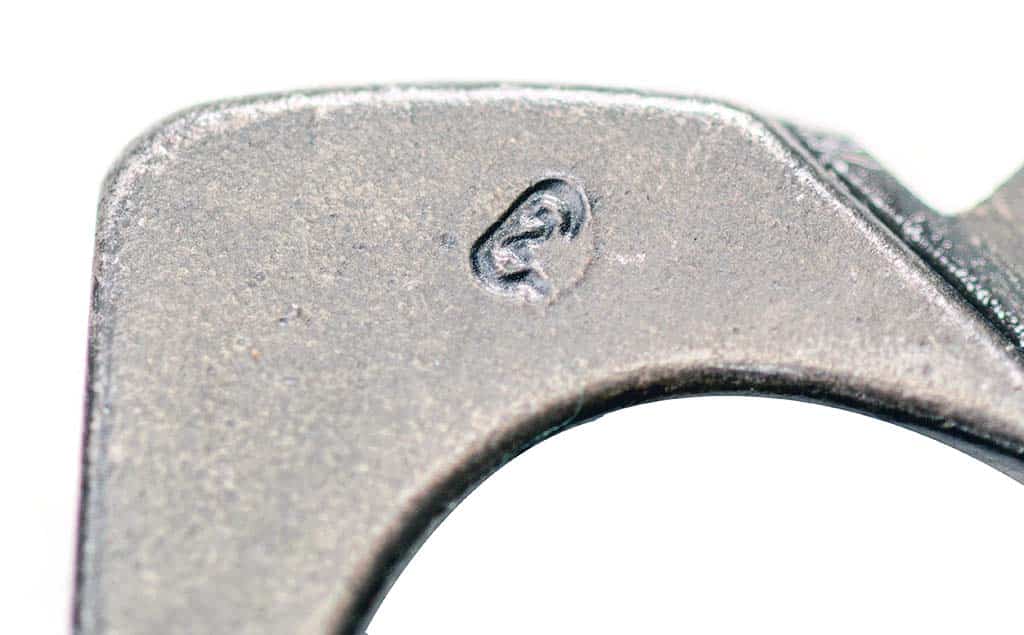
The assembly of a “correct” GM/Hydra-Matic replica rifle can be quite expensive. When building a Vietnam-era copy the quest for an all-original clone usually ends at the lower receiver; most must settle for using a modern replica semiautomatic receiver. There are a few companies that will duplicate the GM/Hydra-Matic and U.S. Property markings by laser engraving, or roll-marked like the originals were. Most of the available receivers found today are the later reinforced M16A2 design—to be “correct” an M16A1 style lower receiver should be used.
A less expensive alternative to using hard-to-find, expensive original parts for a retro build are reproduction parts from companies like Brownells, NoDak Spud, AR15sport.com and JSEsurplus.com, to name a few.
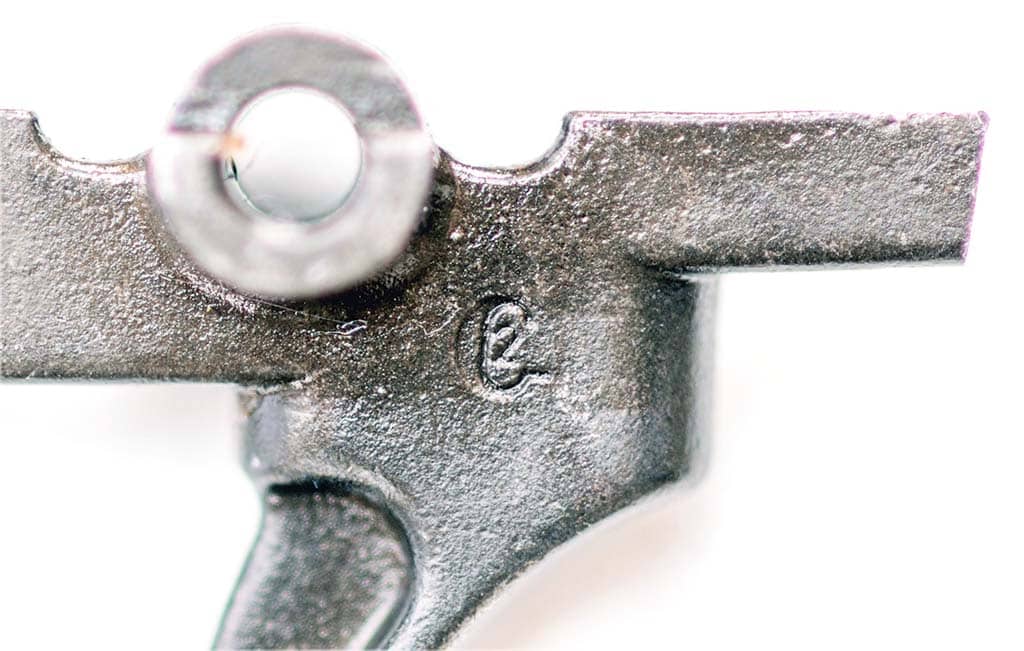
Identifying GM/Hydra-Matic Parts
Original GM/Hydra-Matic and H&R M16A1 parts occasionally surface, knowing how to identify them is key. During the research for this article there were four original GM/Hydra-Matic M16A1 rifles studied, and several internet resources, used as an attempt at identifying parts used in the assembly of GM/Hydra-Matic M16A1 rifles.
There are certain features that are common to most Hydra-Matic manufactured M16A1 rifles; with the small fraction of the weapons available for examination it is not possible to make statements using the word “all.” The attrition rate of 50-year-old Vietnam era M16 rifles, arsenal rebuilding and repair of weapons in the field by armorers, and the large number of subcontractors suppling parts make definitive identification impossible. That said, observations made by the authors and others have concluded the following are common characteristics of M16A1 rifles made by GM/Hydra-Matic.
It is quite likely that many subcontractors were used by GM during the production of their M16A1 rifles. Some of the similar markings on some parts common to GM and H&R rifles suggest that they may have used some of the same subcontractors.
There are several ways to ID GM/Hydra-Matic parts from those from H&R and the far more common Colt parts. Many GM parts are marked with a number, most likely to identify the subcontractor who made the part.
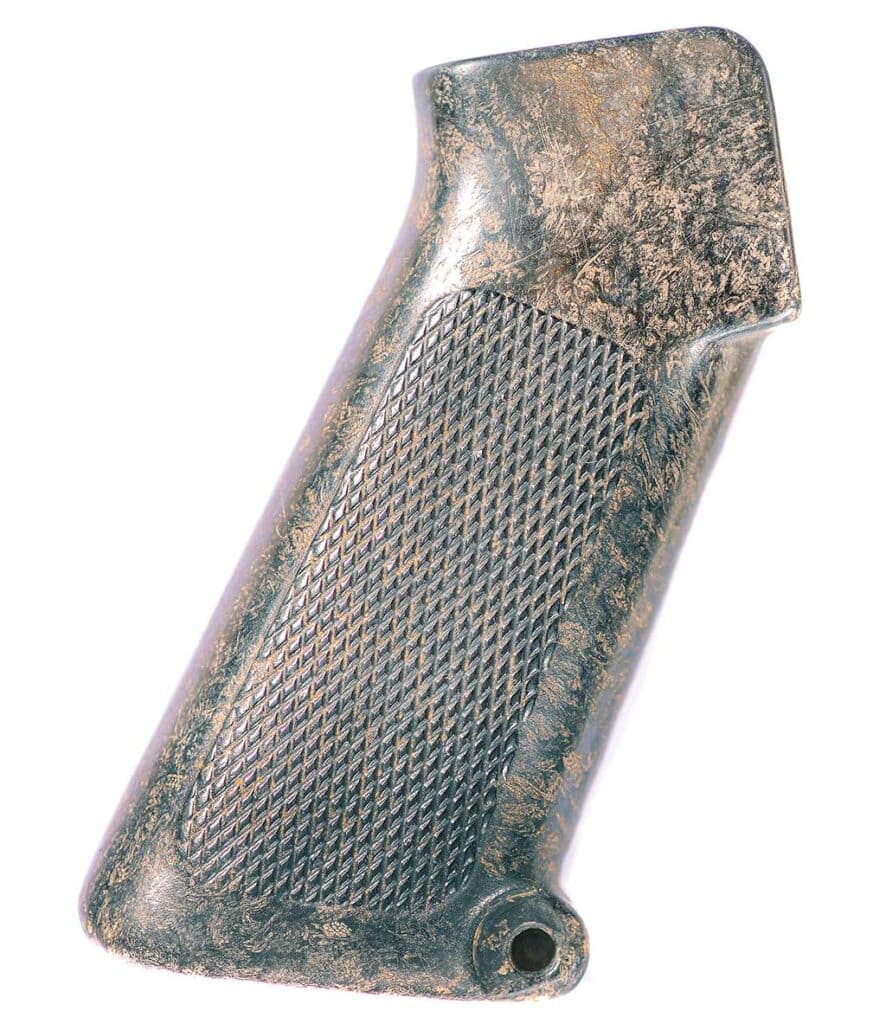
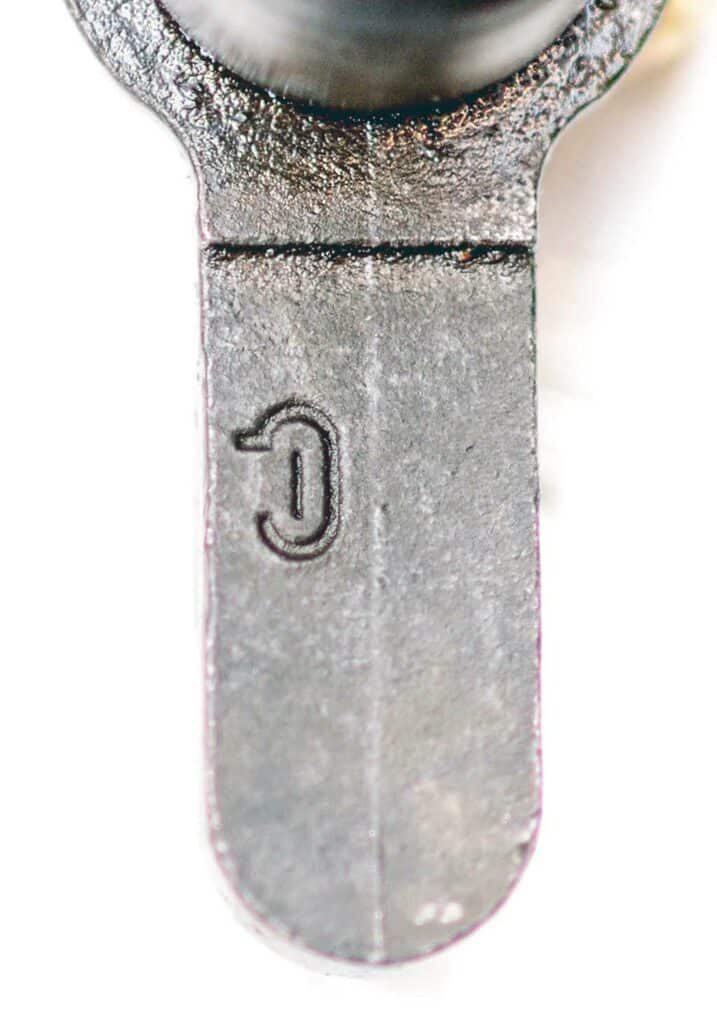
Lower Receiver
The finish color on GM/Hydra-Matic rifles varies, many are darker in color than the 1960s era Colt’s gray. Hydra-Matic Div., G.M. Corp. U.S.A. Property U.S. Govt marked on the left side of the magazine well. On the right side there is a full “fence” around the magazine release, and often a white 1-inch DoD eagle acceptance stamp that is larger than those found on Colt and H&R rifles.
Bolt Stop
GM contract bolt stops have a subcontractor ID number on the bottom. Numbers 1 through 7 have been noted. Bolt stops marked with a number “3” are common.
Upper Receiver
There are variations of the upper receivers documented, one common sign is the lack of markings in the concave area on the right side under the rear sight. Colt contract upper receivers made after 1970 will have two letters in that area. GM upper receivers will generally have a forging flash, or “seam,” on the rear of the carry handle. The front lug is recessed on the left side. The forward assist will have a number on the back side of the teardrop handle. The ejection port door with have a small pad with rounded corners. Any wear of the anodized finish will reveal a yellow-gold color. H&R uppers typically have a forging flash on the front and rear of the carry handle and the rear sight direction arrow is usually different. They often have the same style ejection cover door.
Notes:
- Rifle 3018041 upper receiver no forge seams
- Rifle 3027458 upper receiver no forge seams
- Rifle 3136345 upper receiver forge seam on rear only
- Rifle 3245701 upper receiver no forge seams
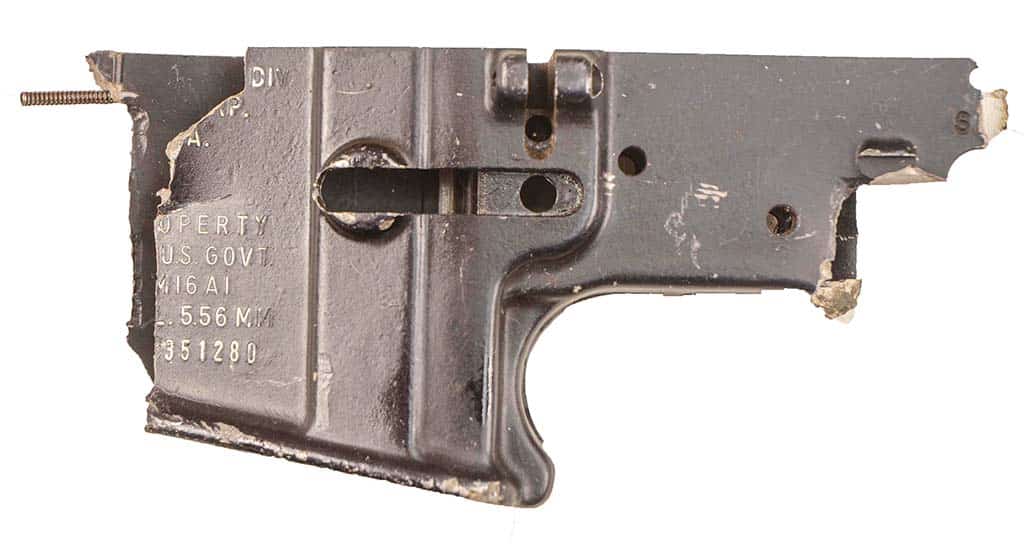
Charging Handle
GM contract charging handles will have six punch marks, or dots, across the back of the handle and have a slightly thinner profile.
Fire Control Group
The fire control components, hammer, trigger and fire selector lever will have a stylized letter “G” with a number inside. The disconnector was not marked. The mode of fire selector levers were marked on the rear surface. Keep in mind that using M16A1 fire control group parts in a semiautomatic AR rifle can cause legal problems. It is strongly suggested that any M16 internal parts be altered to a semiautomatic configuration.
Barrel
The GM barrels with have the letters “MP” on the rightside between the legs of the front sight base. There will be a letter “C” on the top of the barrels indicating chrome chamber. Barrels are the .625-inch outside diameter “pencil” type with a 1:12 twist, and a “birdcage” flash hider. Original barrels are probably the most difficult component to find, many M16 rifles had to be re-barreled due to excessive use and / or corrosion of the bores. Original barrels, front sight blocks and flash hiders typically have a rougher finish machining than those found on Colts. Colt and other contractors made thousands of replacement barrels during the Vietnam War. During 1967, there was a projected demand of 11,800 barrels per month. Note: one of the GM rifles examined, serial number 3018041, had the “MP” mark on top of the barrel under the front sight base.
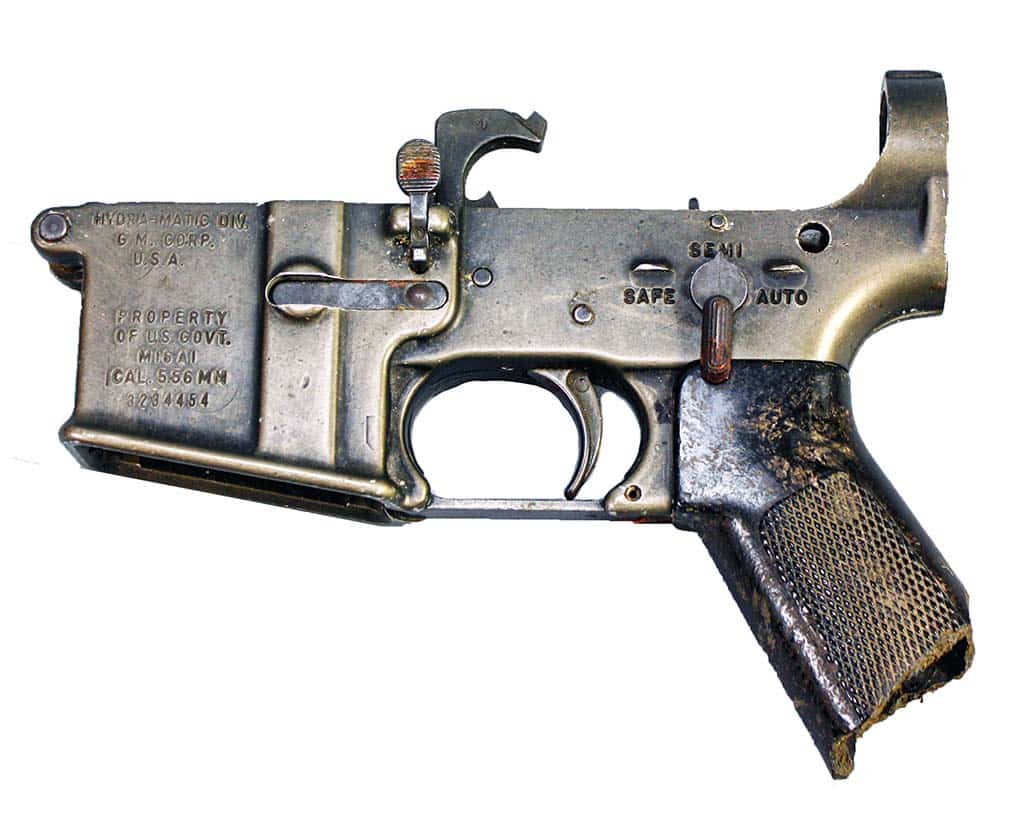
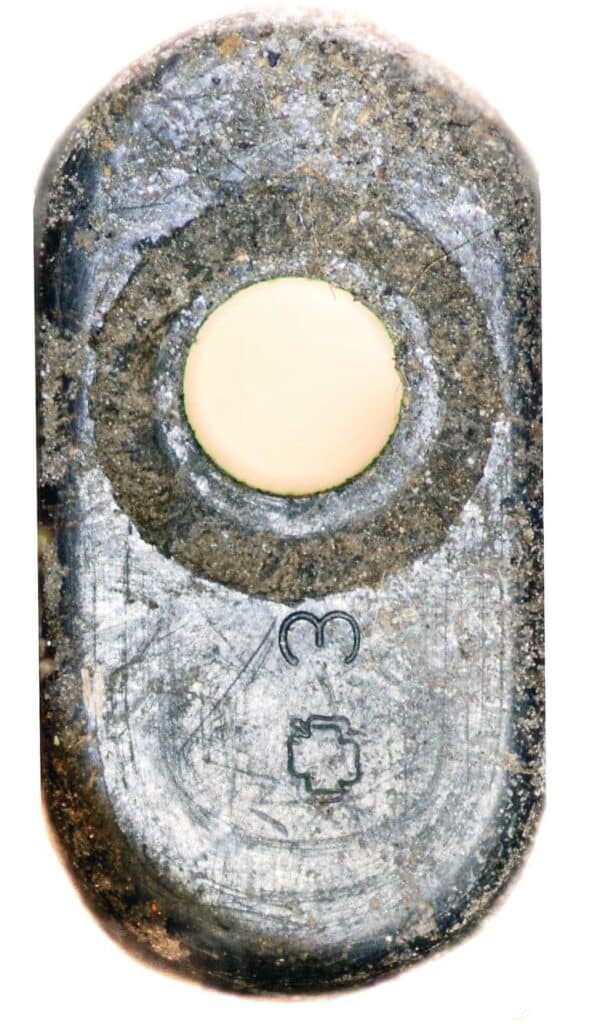
Front Sight Base
There are several front sight base variations. Some have forging flash on the front and/or rear, and on the bayonet lug. Some bases observed had a forging code letter or number on the sides and on the lug for the bayonet. Some are not marked with any codes. None of the rifles examined had any visible markings on the front sight base.
Furniture
Most were fitted with “type D” buttstocks, without trapdoors, a rubber buttplate and a moveable sling swivel. The furniture often has an aged “mottled” appearance. The “fat” pistols grips have a slightly larger circumference than those fitted on Colt M16 rifles. GM pistol grips, handguards and buttstocks will have a raised cross symbol on them, letters and numbers have been observed in various locations. Buttplate screws have a drain hole drilled through the center. Triangle handguards secured with a flat slip ring.
Bolt Carrier and Bolt
GM/Hydra-Matic bolt carriers do not have any manufacturer’s markings; the finish machining appears rougher than on most Colt bolt carriers. The GM bolts were marked “MP” to indicate that they were magnetic particle inspected. The marking is very similar to Colt’s, but the “MP” letters are connected on the GM.

Buffer
The buffer will usually have a dimple on the front and an orange or maroon color pad (possibly discolored with age).
Sling
The sling issued during the Vietnam War was the mildew-resistant nylon sling with cadmium plated hardware. Front and rear sling swivels on all GM/Hydra-Matic rifles were secured with roll pins.
GM/Hydra-Matic Rifles Used for Study
Courtesy of ATF’s Firearms Technical Division. Serial numbers: 3245701, 3018041, 3136345, 3027458. Special thanks to Eve Eisenbise, Anthony Ciravolo and Jeff Bodell (ATF FATD).
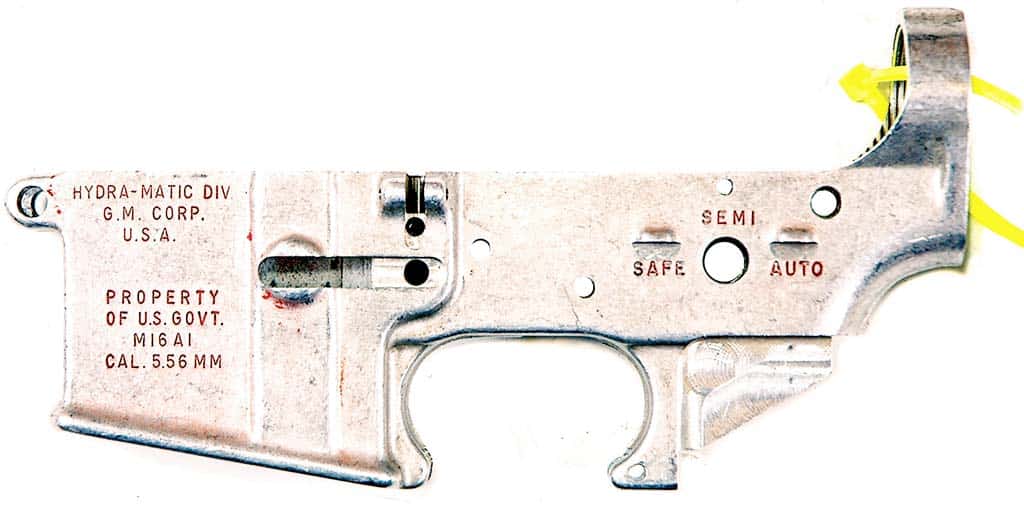
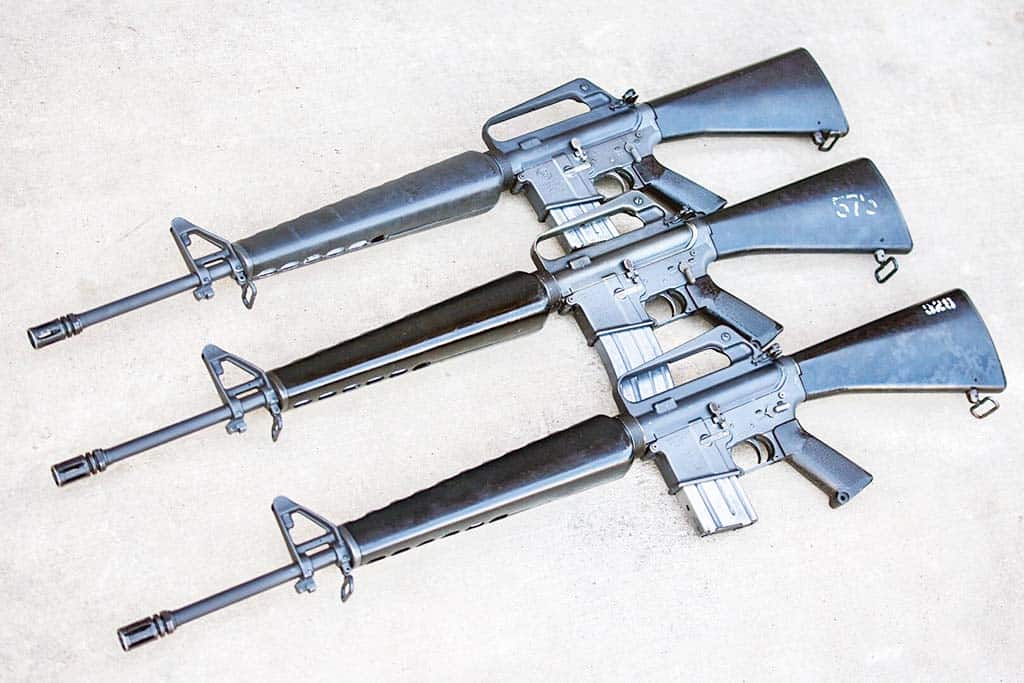
Resources
Government Documents (Declassified)
- Procurement, Production and Distribution of the AR15, M16 and M16A1 Weapon System (1 June 1968)
- Procurement History and Analysis of the M16 Rifle (Printed 2 Aug 71)
- M16A1 Initial Production and Comparison Test; GM. H&R, Colt. (9 Jan 69)
- M16A1 Rifles, Hydra-Matic- collection of Amendments to the original contract and correspondence 1968-1971, on the General Motors Corporation Hydra-Matic Division M16A1 contracts. English Language. (Courtesy Dan Shea, Small Arms Review Reference Library)
Books
- The Black Rifle: M16 Retrospective R. Blake Stevens and Edward C. Ezell
- The Great Rifle Controversy Edward Clinton Ezell
| This article first appeared in Small Arms Review V25N8 (October 2021) |











